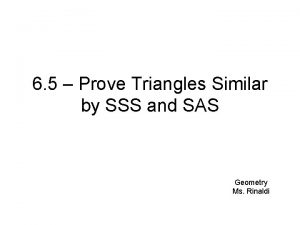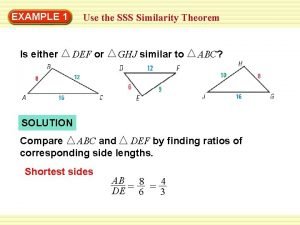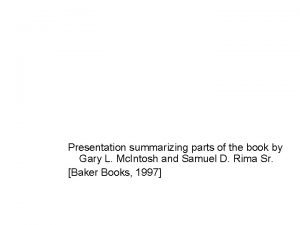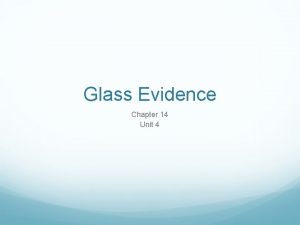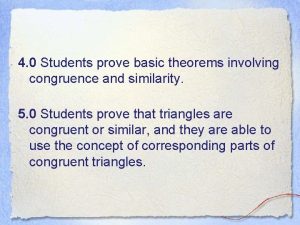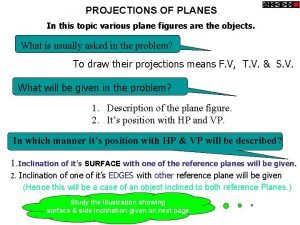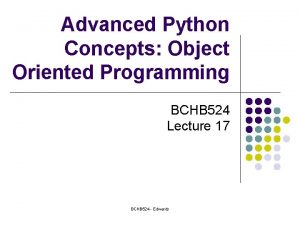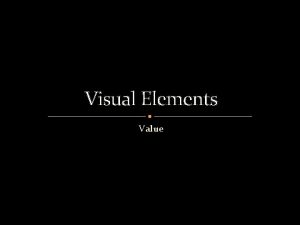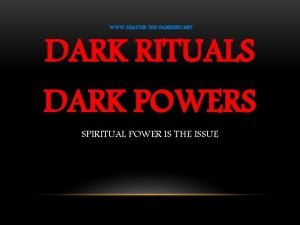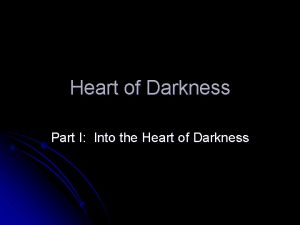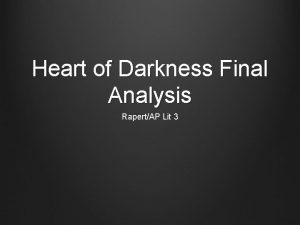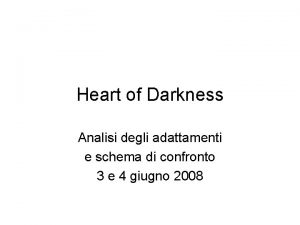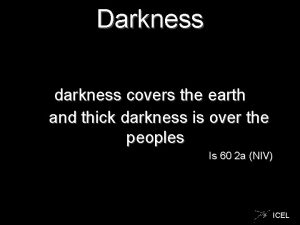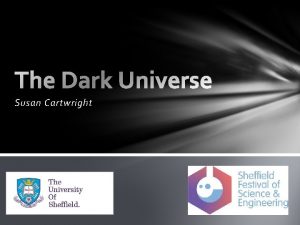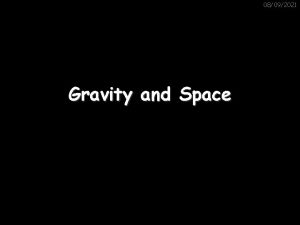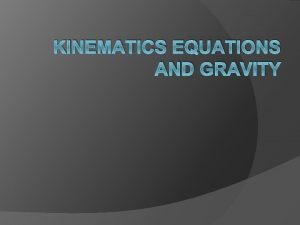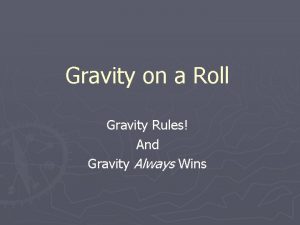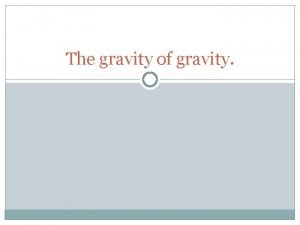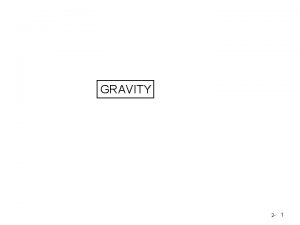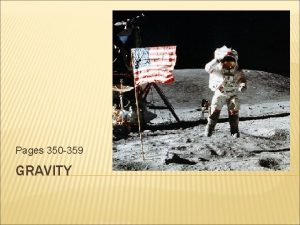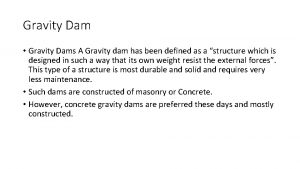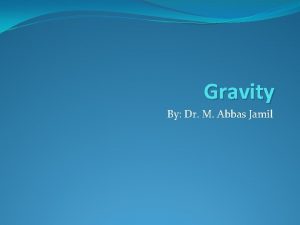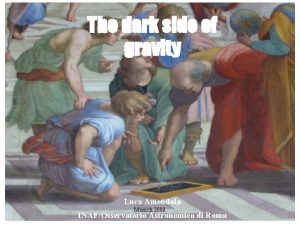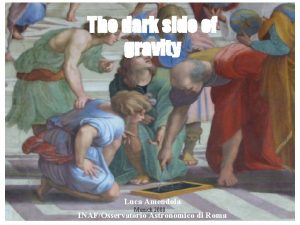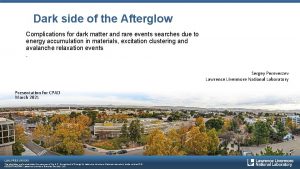The Gravity of Darkness and the Dark Side

















































- Slides: 49

The Gravity of Darkness and the Dark Side of Gravity 朱明中 Chu Ming-chung Department of Physics The Chinese University of Hong Kong

Hello Darkness my old friend, I’ve come to talk about you again …

Science Magazine Breakthrough of the Year 2003 ‘Illuminating the Dark Universe’ ‘Portraits of the earliest universe and the lacy pattern of galaxies in today's sky confirm that the universe is made up largely of mysterious dark energy and dark matter. They also give the universe a firm age and a precise speed of expansion. ’ Science, Vol 302, Issue 5653, 2038 -2039, 19 December 2003. http: //www. sciencemag. org/cgi/content/full/302/5653/2038

Universe as we know it today • Ordinary matter takes up ~5% of total mass; 95% of matter are dark matter • matter accounts for 0. 3 of total energy; 0. 7 are ‘dark energy’ (vacuum energy) • the universe is flat (k = 0) • many new discoveries new questions new observations, theories New Era for Cosmology as a Science!

The Gravity of Darkness and the Dark Side of Gravity • Dark Matter – evidences • Dark Energy – evidences • The CUHK Models - Neutrino Stars - Dark Energy as a Signature of Extra Dimensions Preprints, powerpoint downloadable from http: //www. phy. cuhk. edu. hk/people/teach/mcchu. html

I. Dark Matter

Evidences for Dark Matter • If there were no dark matter: • Galaxies 星系would be much smaller: most stars would have escaped • Galaxy clusters 星系團could not have formed • Hot gas surrounding most galaxy clusters would have escaped There would be much less structures in the universe! • Galaxy collisions would look different Unless Newton’s Gravitation Law is wrong!

Coma Cluster 后髮座星系團 >1000 bright galaxies; each galaxy ~ 1011 stars distance ~ 2. 8 x 108 l. y. s Photo credit: O. Lopez-Cruz (INAOEP) et al. , AURA, NOAO, NSF http: //antwrp. gsfc. nasa. gov/apod/ap 020203. html

Virgo Cluster 室女座星系團 M 87 distance ~ 6 x 107 l. y. s, > 2000 galaxies. 5 o visual angle Milkway is being drawn there at several hundred km/s. Photo credit: Digitized Sky Survey, Palomar Observatory, STSc. I

1. Hot Gas in Galaxy Clusters Large amount of X-ray emitting hot gas (T ~ 108 K) surrounding many galaxy clusters Hot gas mass ~ 10 times stellar mass, typically must have large amount of dark matter to provide enough gravity to hold the hot gas mass in stars << mass in hot gas << total mass typically 1 : 10 : 200 mostly dark matter!

Coma Cluster X-ray image T ~108 K must have large amount of dark matter to provide enough gravity Photo credit: Chandra X-ray Observatory http: //chandra. harvard. e du/photo/2002/0150/ 1. 5 million l. y. s http: //antwrp. gsfc. nasa. gov/apod/ap 020203. html

2. Galaxy Motion in Clusters • Orbital velocities of galaxies inside a galaxy cluster →total mass of galaxy cluster • Zwicky, Smith (1930 s) Virgo and Coma Clusters have much larger mass than visible mass 2. galaxies’ speeds Zwicky

3. Galactic Rotation Curve v (r) r Photo credit: NASA/STSc. I

NGC 3198 from Begeman 1989 UGC 9242 from Vogt et al. M/Mlum ~ 50 http: //astrosun 2. astro. cornell. edu/academics/cours es//astro 201/rotcurve. htm http: //www. astro. queensu. ca/~dursi/dm-tutorial/rot-vel. html

Milkyway 銀河 r 105 l. y. s v (km/s) r (kpc) → Milkyway extended to 3 -6 x 105 l. y. s, but dark! 1 pc ~ 3. 3 l. y. s

4. Gallaxy Collisions galaxy collisions: matter → gravity → matter distribution M 31 Milkyway

Evidences for Dark Matter • • Hot gas surrounding most galaxy clusters Galaxy motion in clusters Galactic rotation curves Galaxy collisions Dark matter are responsible for the emergence of structures in an initially uniform universe! But: What are they? How are they distributed? Why are they there? …. .

Dark matter could be … • Baryonic dark matter: ordinary matter formed from protons, neutrons, electrons, etc. eg. , planets、brown dwarfs、dark nebulae、black They exist, but there are too little of holes them! • Non-baryonic dark matter: neutrinos、axions、 supersymmetric partners (neutralinos, photinos, …) We don’t know whether they exist, and we don’t know their properties! Except neutrinos! We even know they are massive!

How are dark matter distributed? • Make use of gravity: • X-ray telescopes can be used to measure hot gas distribution →matter distribution • Gravitational lens: General Relativity → light distorted by gravity → gravity ~ lens image of a far galaxy →distorted, multiple images → reconstruct mass distribution

Density distribution of dark matter Galaxy Cluster CL 0024+ 1654 galaxy Galaxies are embedded into a glob of dark matter, which also has some structure. dark matter From T. Tyson, using gravitational lensing data

II. Dark Energy

Hubble’s Law v 3 1000 Velocity (km/s) v (104 km/s) v = Hr H = Hubble’s ‘constant’ 1 0 0 r 0 Distance (Mpc) 2 1 pc ~ 3. 3 light years 1929 200 400 r (Mpc) 1999

Fate of the universe: are there enough matter to stop its expansion? matter →gravity →decelerate A, B, C distinguished by measuring the expansion rate of the early universe → measure far away objects But they are dim! more matter

Type IA Supernovae 超新星 • • Explosions of white dwarfs with mass just >1. 4 Mo →same initial conditions, standard and bright →can be observed over long distance Monitor spectra and light curves to identify types Compare visual and absolute magnitudes →distance redshift → receding speed v Extend Hubble’s diagram (v vs. r) to ~10 billion l. y. s Maximum luminosity ~ 109 – 1010 Lo

Accelerating expansion • Found that the expansion of the universe is accelerating! Independently confirmed by Cosmic Microwave Background measurements and large scale structure surveys. • → Dark energy! → repulsive force > gravity by 2. 3 times! What is dark energy?

Einstein’s Cosmological Constant ~ what’s needed! Introduced originally to counteract gravity. L Dark energy = Cosmological Constant?

Wilkinson Microwave Anisotropy Probe Microwave Background = leftover radiations from Big Bang; almost uniform, T ~ 2. 725 K Microwave Anisotropies = fluctuations around mean temperature ~ 10 -5 K; pattern →cosmological parameters

WMAP results of Cosmological parameters C. L. Bennett et al. , 2003, Ap. JS, 148, 1

Large Scale Structure Survey Obtained redshifts of 220, 000 galaxies, 23, 000 quasars Clustering of matter gives information on cosmological parameters, especially matter content http: //www. aao. gov. au/2 df/

Sloan Digital Sky Survey Aims to measure the positions and brightness of 100 million celestial objects Will measure distances to 106 galaxies, 105 quasars → http: //www. sdss. org/

Universe as we know it today • Ordinary matter takes up ~ 5% of total mass; 95% of matter are dark matter • matter accounts for 0. 3 of total energy; 0. 7 are ‘dark energy’ (vacuum repulsion) • the universe is flat (k = 0) • Cosmic Concordance: independent measurements all agree on a common set of cosmological parameters

L Einstein (after knowing Hubble’s result): L = 0 Quantum Mechanics (vacuum energy): L = 1012 Everybody but Peebles (pre-1998): L = 0 Almost everybody (2005): L = 0. 7 How come? ? ?

III. Our Crazy Ideas

The CUHK Models • Chan Man Ho: neutrino stars could exist, be stable, and provide the necessary gravity to explain various structures in the universe – galaxies, galaxy clusters, hot gas • Cheung Kai Chung, Li Baojiu, Alfred Tang: extra spatial dimensions (1+3+n) can cause the accelerating expansion of the universe, without the cosmological constant

Neutrinos • • Elementary particles – no structure 3 kinds� neutral Only weak and gravity forces, no strong or EM forces • Penetrating: only 1 in 106 interacts (trapped) after passing through the entire Earth • Produced in Big Bang: ~ 300/cc left over • Produced in the sun: 2 x 1038 neutrinos/s http: //www. ps. uci. edu/~superk/neutrino. html http: //wwwlapp. in 2 p 3. fr/neutrinos

Neutrino Star • Can massive neutrinos form a stable ‘star’? • Yes. Hydrostatic equilibrium: gravity balanced by degenerate pressure (Pauli’s Exclusion Principle) General Relativistic, Quantum Mechanical ‘star’!

Neutrino Star Calculate trajectories of stars inside a neutrino star → rotation curve 300 data v (km/s) 200 Neutrino Star theory 100 M. H. Chan 0 0 10 r (kpc) → We live inside a star? 20 30

10 -24 10 -26 Formation of a Neutrino Star: Hydrodynamics t = 5. 5 Gyr Always form (t ~ 6 Gyrs) a stable star at hydrostatic equilibrium with some oscillations t = 4. 9 Gyr (g/cc) t=0 10 -28 0 100 r (kpc) 10000 neutrino star model 10 -24 Provides just the right gravity to hold the hot gas(g/cc) in galactic clusters with 10 -26 the correct density distribution -28 10 Density profile of hot gas 0 100 r (kpc) 1000

Galaxy Cluster CL 0024+ 1654 Doesn’t. Neutrino it look like. Star? a…

Physics with Extra Dimensions Generalize standard physics to (1+3+n) dimensions Kaluza + Klein (1920’s) – General Relativity in (1+3+1) dimensions → gravity + Maxwell Eq. String theory (1990’s) – consistent only for D =11, 26 Brane models (1990’s) – our universe is in only one 4 -d brane of the multi-dimensional universe But we haven’t observed the extra dimensions! Could it be that we need to look at either very large or very small scales to see the extra dimensions? Dark Energy as a Signature of Extra Dimensions? !

1+3+n Cosmology spacetime curvature Generalized Robertson. Walker metric energy-momentum

Generalized Friedmann Equations Effects of extra dimensions (geometric) n = no. of extra dimensions Note: no added in by hand. Instead, are generated automatically → Space-time-matter approach!

Evolution of the universe Scale of the ordinary dimensions a acceleration deceleration Li et al. , CUHK Preprint, 2005. cosmic age ~ 13 GYr t (Gyr) today

Deceleration Parameter reconstructed from SN data in Alam et al. Cosmological constant q(z) CUHK model calculated by Li et al. z = 0: today z > 0: past z Alam et al. , MNRAS 354, 275 (2004).

Dark Energy EOS reconstructed from SN data in Alam et al. w (z) Cosmological constant CUHK model z Alam et al. , MNRAS 354, 275 (2004).

The CUHK Cosmological Model • Pure GR, + extra closed spatial dimensions • No cosmological constant added in by hand; essentially no free parameter (n = 7 preferred, but not a must) • Explains: deceleration, acceleration; Fits: deceleration parameter, dark energy EOS, cosmic age ~13 Gyr (n = 7) • Features robust w. r. t. initial conditions, n, EOS • Spontaneous compactification of extra dimensions • Extra dimensions were large in early universe: signatures of extra dimensions in cosmology!

Rapid compactification of extra dimensions in early universe n=7 today a(t ) b(t ) Li et al. , CUHK Preprint, 2005. t (GYr)

Summary • Dark Matter – need them for the structures in the universe! Numerous proposals for what they are, but mostly particles yet undiscovered. • Dark Energy – accelerating expansion of the universe; Cosmic Concordance → new force? New physics? • Our Crazy Ideas: - neutrino stars → rotation curves, hot gas profiles, galaxy cluster formation; perhaps the largest ‘star’ in the universe! - extra dimensions → cosmic acceleration, cosmic age, dark energy EOS; signatures in early universe? Dark force is a part of gravity, signature of extra dimensions? Preprints downloadable from http: //www. phy. cuhk. edu. hk/people/teach/mcchu. html

The Gravity of Darkness and the Dark Side of Gravity 朱明中 Chu Ming-chung Department of Physics The Chinese University of Hong Kong
 Prove sss similarity theorem
Prove sss similarity theorem Identify the similar triangles.
Identify the similar triangles. Sss similarity theorem examples
Sss similarity theorem examples Aa similarity theorem
Aa similarity theorem Gravity for dummies and dummies for gravity equations
Gravity for dummies and dummies for gravity equations Dark matter and dark energy ppt
Dark matter and dark energy ppt In a dark dark town
In a dark dark town Dark side of leadership
Dark side of leadership Overcoming the dark side of leadership
Overcoming the dark side of leadership Gothic story and dark secrets
Gothic story and dark secrets The dark side of individualism
The dark side of individualism Nnn dark side
Nnn dark side Bob dylan dark side of the road
Bob dylan dark side of the road Advantages of balanced occlusion
Advantages of balanced occlusion Tan geometry formula
Tan geometry formula What is server side programming
What is server side programming Movement of mandible muscles
Movement of mandible muscles Perfect competition side by side graphs
Perfect competition side by side graphs Uil side by side
Uil side by side Sell side vs buy side
Sell side vs buy side Soda lime uses
Soda lime uses Side angle side theorem
Side angle side theorem Two wheels roll side by side
Two wheels roll side by side Iso weld symbols
Iso weld symbols A semicircular plate of 80mm diameter
A semicircular plate of 80mm diameter Melkgeschirr aufbau
Melkgeschirr aufbau Side by side stuff
Side by side stuff Videocon side by side refrigerator
Videocon side by side refrigerator Red side blue side
Red side blue side Who breaks the power
Who breaks the power Flecked darkness
Flecked darkness The relative lightness and darkness of surfaces.
The relative lightness and darkness of surfaces. Who breaks the power lyrics
Who breaks the power lyrics It brings together a composition with similar units
It brings together a composition with similar units Light and darkness by emilio jacinto
Light and darkness by emilio jacinto Symbols heart of darkness
Symbols heart of darkness Romeo and juliet act 5 key quotes
Romeo and juliet act 5 key quotes Romeo and juliet vs west side story venn diagram
Romeo and juliet vs west side story venn diagram Shatterthedarkness.net
Shatterthedarkness.net Heart of darkness as a modern novel
Heart of darkness as a modern novel The migration of darkness analysis
The migration of darkness analysis Heart of darkness map
Heart of darkness map Heart of darkness summary part 2
Heart of darkness summary part 2 Heart of darkness summary
Heart of darkness summary Heart of darkness deaths
Heart of darkness deaths Heart of darkness
Heart of darkness Heart of darkness analysis
Heart of darkness analysis Heart of darkness introduction
Heart of darkness introduction Heart of darkness theme
Heart of darkness theme Darkness conceals hazards such as
Darkness conceals hazards such as
